Last Updated on October 18, 2023
If limited space is the problem that keeps you from gardening, create yourself a container garden. Choose right spot, get right pot (and plants🙂) and you are well on your way!
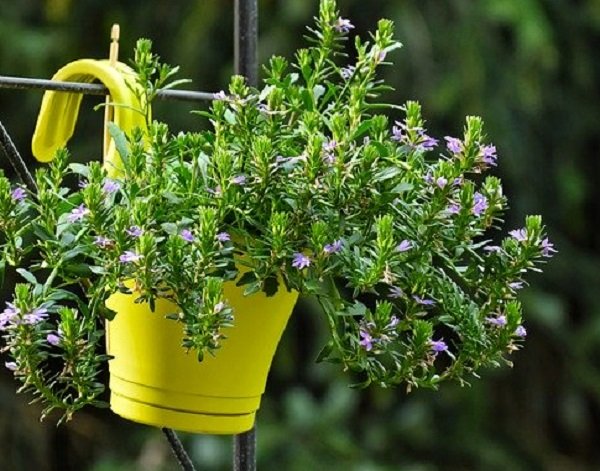
A very tiny garden🙂 in a fence bucket pot.
*This post contains affiliate links. If you choose to purchase any of the products I have recommended, I may receive a commission at no cost to you.
Starting up a garden can be a real challenge to people who live in places with very limited, or nonexistent, yard space. But it should not prevent you from creating a garden of your own. You can grow your garden in containers.
What is a container garden?
A container garden is simply nothing more than a garden of potted plants.
With this type of garden, you have the opportunity to plant a wonderful selection of vegetables, herbs, fruits, and flowers to sustain your body and uplift your soul.
You can have your potted plants on the deck, patio, or porch. If you live in an apartment building and you have a balcony – use it as the site of your container garden. If you do not have a balcony, maybe a spot inside the apartment that gets some sunlight will do.
If space is really tight – go vertically! Get yourself a multilayer plant shelf where you can put more potted plants or hanging strawberry planter and build your container garden up, (or down 🙂).
Related reading:
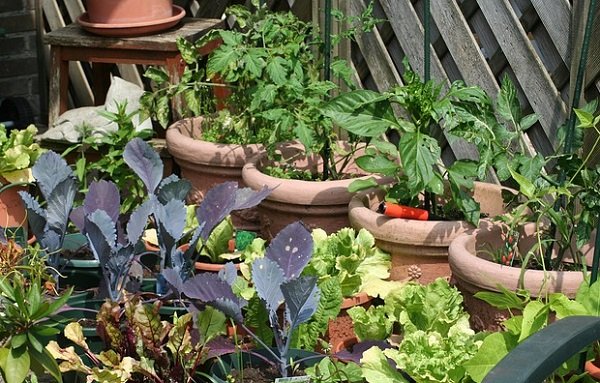
Vegetable garden in pots.
Benefits of container gardening:
Besides being fitted for small spaces, growing vegetables, herbs and flowers in containers has other benefits:
- you can move containers for sheltering plants from severe weather conditions (it is easy to do if you set your containers on planter caddies).
- you will spend less time on weeding your container garden compared to conventional garden
- plants grown in containers most likely will suffer less from wildlife invaders compared to in ground beds in the yard
- a container restrains growth of useful but invasive plants (like lemon balm, or mint)
- you won’t deal with poor heavy clay soil
- if you get a raised planter, your gardening in “golden years” will be more enjoyable and easier.
This is a type of planter I use on my deck. It has ample space for plants and is easy on my back and knees.
The drawbacks of container gardening
- plants grown in containers require frequent watering
- drainage needs to be sufficient so the plant roots won’t rut
- some plants just will not grow in containers
- pots can restrict plant growth
- because the soil for your container garden is formulated to drain quickly, fertilization will be a quite important issue
- you need to have a plan how to overwinter your pots
- large pots are quite expensive
- just like with owning an actual garden planted on a piece of land, taking care of a container garden takes some work, time, and attention.
Setting Up Your Container Garden
If you have decided to create your very own container garden, you have to plan a little on how to set it up.
Let’s see what needs to be taken into consideration.
First of all, pick the right spot!
Figure out where you can put your container garden
Decide ahead of time where you want your pots to be positioned, and then buy plants that suit the situation. There is no point buying sun lovers for a shady position, for they will not do well. Some plants (especially perennials) have really large roots, so they are best kept for the open garden.
Take into account sun, wind and rain exposure
- Make sure your plants get enough sunlight. But exposure to direct sunlight at the hottest part of the day might kill tender plants, so think how to shelter your plants in summer from excessive heat
- Protect your potted plants from strong winds
- Check if your potted plant is not placed in the spot where water is pouring down from the roof during rainstorms.
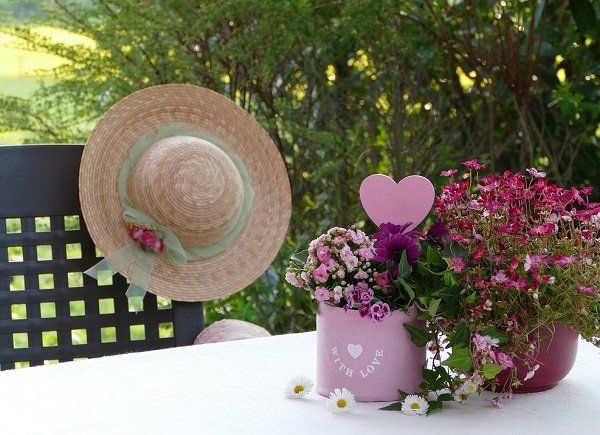
Cheery potted flowers – an instant mood lifter!
Choose right plants
Most plants can adapt and survive being potted.
There are a few things to remember, though.
- Since plants in pots tend to dry up more easily than those planted on the ground, it would be best to pick plants that are more resistant to lack of moisture
- Consider small, fast growing crops, because they generally do the best in containers.
- When possible, choose compact or dwarf cultivars of normally large plants (for example, melons, squash, cabbage, cucumbers).
Here are some suggestions for plants that do well in containers:
Vegetables: bush beans, cucumbers, peas (if planted near railings), compact zuccini and summer squash varieties, eggplants, tomatoes, peppers, kale, broccoli, salad greens, onions.
Flowers: geranium, calendula, viola, pansy, chrysanthemum, dianthus, petunia, iris, alyssum, nasturtium, verbena, impatiens, zinnia, cosmos, marigold, painted daisy, dusty miller, coleus, salvia, snapdragons, wax begonia.
Fruits: strawberries, alpine strawberries, blueberries, grapes, pomegranates, jujube.
Herbs: basil, cilantro, lemongrass, sorrel, garlic chives, chives, lemon balm, Korean mint, parsley, dill, sage, thyme, rosemary.
Related reading:
Get right pot
You can ensure the long survival of your container garden if you choose your pots carefully.
When getting a pot – think about size and material the pot is made of.
If the plants you pick are those that grow big, you should put these plants into pots that will give enough room for them to expand.
If you plant deep rooted vegetables (carrots, beets, potatoes), your container should be pretty deep. For deep rooted plants, I personally like to use these reusable smart potato bags with visualization window, made of non woven fabric.
Useful Tip
Wonder what is the right size of container you should pick for your plant, and how many gallons of soil each size of container holds?
Then check out this container guide from Miracle-Gro.
A few pointers on choosing planter material
- metal and glazed ceramic pots are nonporous, so they keep soil moist longer
- metal pots can become very hot though under direct sun rays
- terra-cotta pots are porous which allows soil to dry out more quickly
- if your potted plants will sit on a deck or a rooftop, choose a container made of lightweight materials, such as metal or composite
- fiberglass planters are the most durable containers for plants. Learn if these planters are suited for your needs here.
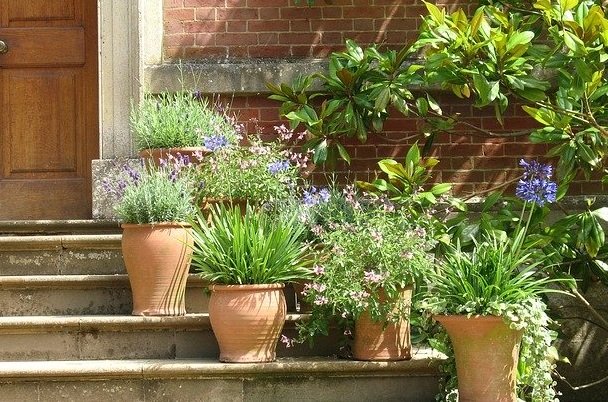
Dressing up an entryway with potted plants.
Drainage of excess water is vital
You should always plant in pots with drainage holes. If the pot is decorative and does not have drainage holes, put the plant in a plastic container that has a drainage hole in it and then place this container inside your decorative pot. Just after rain and watering check to be sure that the plants never stand in water collected by outer decorative pot.
Based on my own experience – I would skip the pots with attached saucers because the roots of plants in these containers become waterlogged easily which causes root rot.
How to make a drainage hole in a pot
If a container doesn’t have a good drainage hole in the bottom – you can make one by yourself.
Just put two pieces of masking or duct tape in a crisscross pattern on the bottom of container and then with a small drill begin to drill through the center, slowly working your way outward until the size is approximately 1/2″ – 3/4″ in diameter.
If you’re drilling a ceramic pot, then use a masonry bit and avoid putting too much pressure on the drill and bit in order to avoid cracking the pot.
A better idea though, would be to drill four 1/4 inch holes in the bottom of the pot for efficient drainage.
Now, knowing how to make a drainage hole, you can use literally anything for a container. For instance, some great choices for your garden container include things such as whiskey barrels, kitchen bowls, ceramic pots, watering cans, old bathtubs, you name it, and you could probably start a container garden in it. As long as the container will hold soil, plants, water, and have a drainage hole – you are set to go.
Get good soil
The soil that you will use for your container garden should be the type that can keep moisture for as long as it can and yet drain easily to keep the air in good circulation. It should allow enough moisture to keep roots moist without the plants sitting in soaking wet soil, which can lead to root rot and other diseases.
Soil mix, rather than garden soil, is best to use for potting plants.
Best potting soil designed for container planting:
- Fox Farm Happy Frog organic potting soil mix – it’s pH adjusted and amended with soil microbes that can help improve root efficiency and encourage nutrient uptake.
- Burpee natural organic premium growing mix – enriched with Burpee plant food for vibrant flowers and delicious vegetables and herbs. Made with coconut coir that helps maintain moisture between waterings.
- Espoma organic potting mix – improves moisture retention and reduces drought stress due to enhancement with myco-tone water saving formula.
Gardening Tip
Prior to placing the soil in the container, put paper towels or old newspaper on the bottom of the pot to hold the soil in.
Do not put broken pot shards or gravel on the bottom of container to help keep the soil inside the pot, because they can shift and plug the drainage hole.
Planting your container garden
Watch YouTube video and follow the steps.
Maintaining Your Container Garden
Container gardens need constant maintenance because they are more vulnerable to drying and wilting than gardens actually planted on the ground.
1) Ensure regular and generous watering.
Water potted plants when the top 1-2” of soil is dry. Water thoroughly so that water comes out the bottom of your container to be sure you have saturated the soil.
2) The soil should be loosened every now and then to promote air circulation and to prevent disease causing bacteria from thriving in the soil mix.
3) Ideally, your potted plants should be protected from direct sunlight when it is the hottest time of the day. Use plant caddies to wheel your plants away from the scorching sun rays during excessive summer heat.
4) Because the soil for your container garden is formulated to drain quickly, fertilizer is important. A good rule of thumb is that the lighter the soil the more frequent you will need to fertilize.
Dr. Earth organic and natural fertilizer is the best organic fertilizer for potted plants, in my opinion. I like that this fertilizer is pet and human friendly and does not have synthetic chemicals, GMO infested chicken manure, or toxic ingredients. It’s enriched with multi-minerals, proteins, carbohydrates, and trace elements that promote the healthiest soils so vegetables and herbs grow healthy.
5) If your plant outgrows the pot – give it a new home! Replant it in a larger pot.
6) To learn about overwintering container grown ornamentals – follow this link.
There you go! We got all basics covered!
Read more on what kind of small garden you can start
Final thoughts on container gardening
Container gardens are the ideal solution for people who enjoy gardening but simply have little to no space. With this type of garden, you have the opportunity to plant a wonderful selection of vegetables and flowers, but instead of using land outside, you use small containers. To get started – pick the right spot for your container garden, get the right pot, soil and plants, and your garden is ready to go!
Happy gardening!👩🏽🌾
If you found this article useful – be so kind to share with friends.
You have read:
How to start a container garden
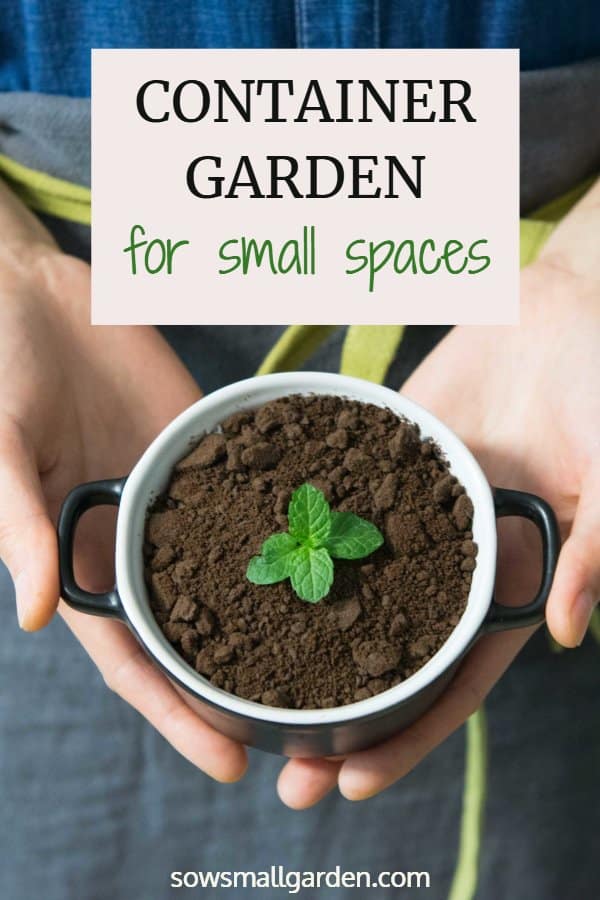
Pin for later reference!


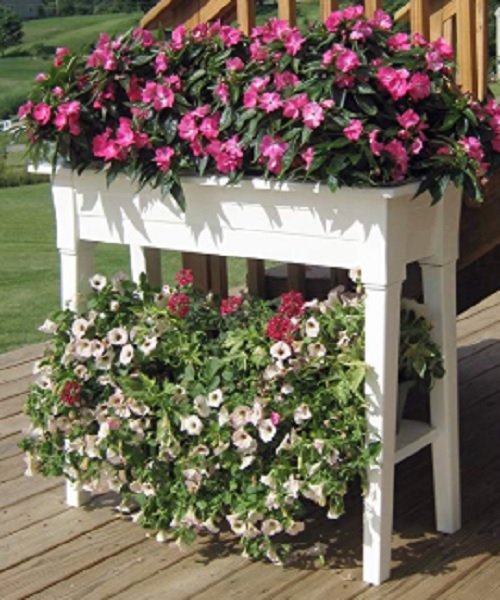
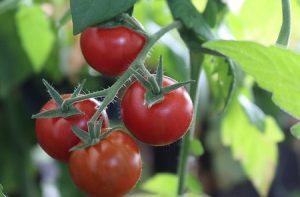
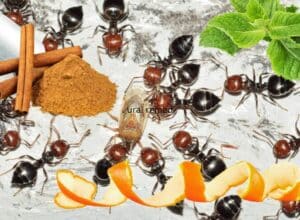
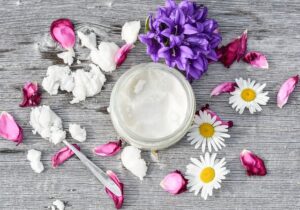
Especially if you live in a small space with little or no land, container gardening is an excellent option that can allow you to grow some of your own food without the need for lots of land. With seed packets costing less than $5 on average and yielding an abundance of food, learning how to container garden I would argue is one of the best ways that you can feed yourself and your family organic, nutrient dense foods and save a ton of money in the process.
Entirely agree, Alberte!